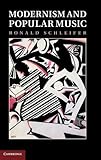Modernism and popular music / Ronald Schleifer.
Publication details: Cambridge: Cambridge University Press, 2011.Description: xx, 233 p. : illISBN:- 9781107005051 (hardback)
- Modernism (Music)
- Popular music-United States
- Jazz-History and criticism
- Gershwin George, 1898-1937-Criticism and interpretation
- Holiday,Billie,1915-1959-Criticism and interpretation
- Porter, Cole, 1891-1964-Criticism and interpretation
- Waller,Fats, 1904-1943-Criticism and interpretation
- Popular music-United States-History and criticism
- 781.640 904 1 Q1
| Item type | Current library | Call number | Status | Date due | Barcode | Item holds |
|---|---|---|---|---|---|---|
 Books
Books
|
Mahatma Gandhi University Library General Stacks | 781.640 904 1 Q1 (Browse shelf(Opens below)) | Pending hold | 51014 | 1 |
Browsing Mahatma Gandhi University Library shelves, Shelving location: General Stacks Close shelf browser (Hides shelf browser)

|

|

|

|

|

|

|
||
| 781.542 082 097 3 Q5 Seeing through music: | 781.542 Q4 The Oxford handbook of film music studies/ | 781.542 Q9 Music and sound in silent film from the Nickelodeon to The Artist | 781.640 904 1 Q1 Modernism and popular music / | 781.64 Q5 Preserving popular music heritage: | 782.1 Q8 Benjamin Britten and Montagu Slater's Peter Grimes/ | 782.27 111 Q1 Hymns to the Goddess and Hymn to Kali/ |
Machine generated contents note: Preface; Introduction: popular music and the experience of modernism; Part I. Musical Modernism: Popular Music in the Time of Jazz: 1. Classical modernity and popular music; 2. Twentieth-century modernism and 'jazz' music; Part II. Gershwin, Porter, Waller, and Holiday: 3. Melting pot and meeting place: the Gershwin brothers and the arts of quotation; 4. 'What is this thing called love?': Cole Porter and the rhythms of desire; 5. Signifying music: Fats Waller and the time of jazz; 6. Music without composition: Billie Holiday and ensemble performance; Postscript: popular music and the revolution of the word; Bibliography; Index.
Includes bibliographical references (p. 216-225) and index.
"Traditionally, ideas about twentieth-century 'modernism' - whether focused on literature, music or the visual arts - have made a distinction between 'high' art and the 'popular' arts of best-selling fiction, jazz and other forms of popular music, and commercial art of one form or another. In Modernism and Popular Music, Ronald Schleifer instead shows how the music of George and Ira Gershwin, Cole Porter, Thomas 'Fats' Waller and Billie Holiday can be considered as artistic expressions equal to those of the traditional high art practices in music and literature. Combining detailed attention to the language and aesthetics of popular music with an examination of its early twentieth-century performance and dissemination through the new technologies of the radio and phonograph, Schleifer explores the 'popularity' of popular music in order to reconsider received and seeming self-evident truths about the differences between high art and popular art and, indeed, about twentieth-century modernism altogether"--
"Introduction: popular music and the experience of modernism This is a book about the "cultural modernism" of the early twentieth century. Part I examines the place of popular music within conceptions of modernism, and Part II examines what I call "the rhythms and semiotics of language and sound" in the music of the Gershwin brothers, Cole Porter, Thomas "Fats" Waller, and Billie Holiday, with occasional references to modernist writers William Butler Yeats, T S. Eliot, Ralph Ellison, William Carlos Williams, Virginia Woolf, and others. The emphasis of Modernism and Popular Music is primarily linguistic or textual in that I am pursuing an account of how a "revolution in words," as I note in the Conclusion, transformed or marked the ways in which sensibility, mind, belief, perspective, society, economics, and human experience more generally came to be understood in the early twentieth century. I argue, however, that this revolution, which is usually associated with poets, writers, artists, linguists, and philosophers - as well as twentieth-century composers of "art" music - is just as evident, if not more so, in the work of the great songwriters and jazz performers who came to prominence in the United States between the two World Wars"--


There are no comments on this title.